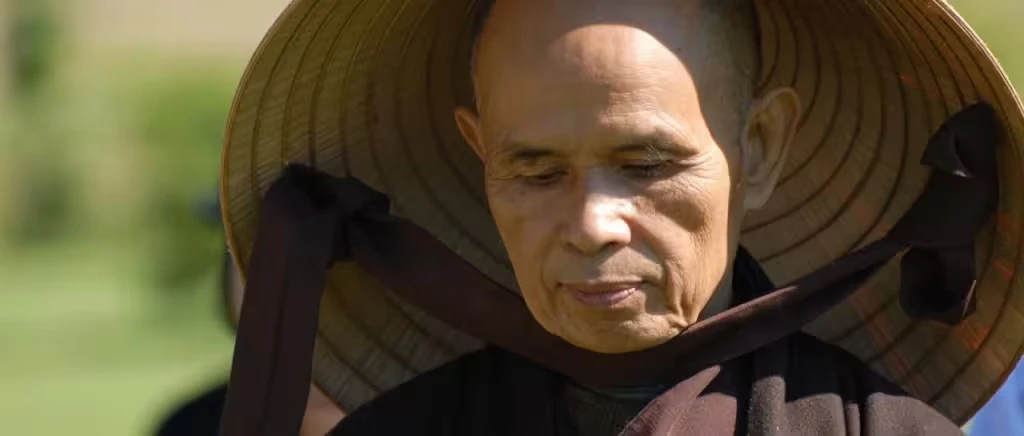“Peace Is Every Step” by Thich Nhat Hanh is a transformative guide that brings the practice of mindfulness into everyday life. Written by one of the world’s most respected Zen masters, this book shows how to cultivate peace and joy through simple, mindful living. Through gentle wisdom and practical exercises, Thich Nhat Hanh demonstrates how every moment can become an opportunity for inner peace. This book is ideal for anyone seeking tranquility in our fast-paced world, from meditation beginners to experienced practitioners, and especially those feeling overwhelmed by daily stress.
Key Concepts
Mindful Breathing
At the heart of Thich Nhat Hanh’s teachings is the practice of mindful breathing. He explains that our breath serves as an anchor, connecting our mind and body in the present moment. Through the simple practice of following our breath, we can find immediate peace. In the book, he shares the story of a young executive who transformed his hour-long commute from a stressful ordeal into a peaceful meditation session by focusing on his breath while stuck in traffic. This practice became so powerful that the executive started looking forward to his commute as a time of renewal. The author also describes how Vietnamese refugees used mindful breathing to cope with panic attacks and find stability in their new lives.

Present Moment Awareness
The author emphasizes that peace can only be found in the present moment. He illustrates this through the metaphor of washing dishes: one can view it as a burdensome chore to rush through, or as an opportunity to be fully present and find joy in the simple act of cleaning. “While washing the dishes, you might be thinking about the tea afterwards, and so try to get them out of the way as quickly as possible in order to sit and drink tea. But that means that you are incapable of living during the time you are washing the dishes.” Through such everyday examples, he shows how mindfulness can transform routine activities into opportunities for peace and joy.
Interbeing
Thich Nhat Hanh introduces the concept of “interbeing” - the interconnected nature of all things. Looking deeply at a sheet of paper, he explains, we can see the sun, the tree, the logger, and countless other elements that made its existence possible. This understanding naturally cultivates compassion and environmental awareness. He shares how this perspective helped him maintain peace and compassion even during the Vietnam War, seeing the humanity in all sides of the conflict. This deep understanding of interconnectedness becomes a foundation for peaceful living and social action.
Transforming Suffering
Rather than avoiding difficult emotions, Thich Nhat Hanh teaches how to embrace and transform them. He uses the analogy of composting, showing how we can transform the “garbage” of our pain and anger into the “flowers” of understanding and compassion. He shares the story of a young refugee who transformed her anger and grief through mindful breathing and walking meditation. The book provides practical exercises for handling strong emotions, demonstrating how mindfulness can help us acknowledge and transform our suffering rather than being overwhelmed by it.
Mindful Community
The importance of community, or “Sangha,” is emphasized throughout the book. Thich Nhat Hanh explains how practicing mindfulness with others can strengthen our own practice and create ripples of peace in society. He shares experiences from Plum Village, his meditation center in France, where people from different backgrounds come together to practice mindful living. Through community practice, individual transformation becomes social transformation. He illustrates this with examples of how mindful communities have helped heal divisions and create positive change in various settings, from families to workplaces.
Engaged Buddhism
Thich Nhat Hanh presents a form of Buddhism that actively engages with social issues while maintaining inner peace. He shares his experiences during the Vietnam War, where he and his students practiced meditation while actively helping war victims. This demonstrates how spiritual practice can fuel effective social action rather than leading to passive withdrawal. He emphasizes that true peace work begins with cultivating peace within ourselves: “If we are not peaceful, then we cannot contribute to the peace movement.”
Conclusion
“Peace Is Every Step” remains profoundly relevant in our increasingly fast-paced and stressed world. Its message - that peace is available in every moment through mindful living - offers a practical path to personal and social transformation. Thich Nhat Hanh’s gentle wisdom and concrete practices provide tools for finding peace amidst life’s challenges, making this book a timeless guide for anyone seeking greater peace and awareness in their daily life.
Did you find this content helpful?
While we strive to provide comprehensive summaries, they cannot capture every nuance and insight from the full book. For the complete experience and to support the author's work, we encourage you to read the full book.
Note: You'll be redirected to Amazon.com. We may earn a commission from purchases made through affiliate links on this page.
Recommended Books
If you enjoyed “Peace Is Every Step”, these books in similar topics might interest you:
- "The Heart of the Buddha's Teaching" by Thich Nhat Hanh : A deeper exploration of Buddhist principles and practices that expands on the mindfulness concepts introduced in Peace Is Every Step.
- “Real Change” by Sharon Salzberg: Offers practical mindfulness techniques for social change and activism, complementing Thich Nhat Hanh’s teachings on engaged Buddhism.
- "When Things Fall Apart" by Pema Chödrön : Provides Buddhist wisdom for difficult times, offering another perspective on transforming suffering through mindfulness.
For different but complementary perspectives, consider:
- "Atomic Habits" by James Clear : While not a spiritual book, it offers practical strategies for building positive habits that can support a mindful lifestyle.
- “Why We Sleep” by Matthew Walker: Explores the science of rest and renewal, which aligns well with mindfulness practices for overall wellbeing.